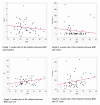Correlation Between Different Parameters of Acute Myocardial Infarction and Obesity
- PMID: 36185847
- PMCID: PMC9520635
- DOI: 10.7759/cureus.28572
Correlation Between Different Parameters of Acute Myocardial Infarction and Obesity
Abstract
Objective: To study if obesity had a detrimental effect on troponin after acute coronary syndrome. We investigated the effects of the body mass index (BMI) in post-myocardial infarction (MI) patients, and see the difference in troponin levels and other parameters between normal and overweight patients.
Methodology: A retrospective cohort study was conducted. Data were extracted from the electronic medical files of patients hospitalized due to acute ST-elevation MI to examine the association between BMI and MI. Sixty-one patients were categorized into normal BMI category, overweight, and obese/morbid obesity groups using the baseline measurements, to assess the independent factors associated with a patient with a high BMI who had a MI.
Results: In total, 61 post-myocardial infarction patients with a mean age of 56.9 ± 11.2 years were included in the study. The average BMI was 28.5 ± 6.5 kg/m2. Just more than a third (37.4%, n=23) were in the normal BMI category, 19 (31.2%) overweight, and 19 (31.2%) obese/morbid obesity. The mean left ventricle mass was 93.74 ± 32.69 gram and the mean left ventricular ejection fraction was 44.02% ± 10.02. A significant difference in the mean level of troponin and mean heart rate between the body mass index groups (normal vs. overweight groups) was noted. A fair correlation was noted between BMI and left ventricle mass. No statistically significant relation could be linked to high BMI with total cholesterol, low-density lipoprotein (LDL), or aspartate transferase/alanine transaminase (AST/ALT) levels.
Conclusions: In this pilot study, the group with a high BMI had a statistically significant lower troponin level and higher mean heart rate. Such data need to be considered when assessing a patient's risk. In addition, obese persons with a MI had a higher left ventricle mass.
Keywords: body mass index; left ventricle mass; myocardial infarction; obese; troponin.
Copyright © 2022, Alqahtani et al.
Conflict of interest statement
The authors have declared that no competing interests exist.
Figures
Similar articles
-
BMI, Infarct Size, and Clinical Outcomes Following Primary PCI: Patient-Level Analysis From 6 Randomized Trials.JACC Cardiovasc Interv. 2020 Apr 27;13(8):965-972. doi: 10.1016/j.jcin.2020.02.004. JACC Cardiovasc Interv. 2020. PMID: 32327093
-
Relationship Between Myocardial Function, Body Mass Index, and Outcome After ST-Segment-Elevation Myocardial Infarction.Circ Cardiovasc Imaging. 2017 Jul;10(7):e005670. doi: 10.1161/CIRCIMAGING.116.005670. Circ Cardiovasc Imaging. 2017. PMID: 28701527
-
Association of body mass index and long-term outcomes in older patients with non-ST-segment-elevation myocardial infarction: results from the CRUSADE Registry.Circ Cardiovasc Qual Outcomes. 2014 Jan;7(1):102-9. doi: 10.1161/CIRCOUTCOMES.113.000421. Epub 2013 Dec 10. Circ Cardiovasc Qual Outcomes. 2014. PMID: 24326936
-
Myocardial infarction and ischemic heart disease in overweight and obesity with and without metabolic syndrome.JAMA Intern Med. 2014 Jan;174(1):15-22. doi: 10.1001/jamainternmed.2013.10522. JAMA Intern Med. 2014. PMID: 24217719
-
Overview of epidemiology and contribution of obesity to cardiovascular disease.Prog Cardiovasc Dis. 2014 Jan-Feb;56(4):369-81. doi: 10.1016/j.pcad.2013.10.016. Epub 2013 Oct 24. Prog Cardiovasc Dis. 2014. PMID: 24438728 Review.
References
-
- A review of prevalence of obesity in Saudi Arabia. M Alqarni SS. J Obes Eat Disord. 2016;2:2.
-
- Obesity and cardiovascular disease. Jokinen E. https://www.minervamedica.it/en/journals/minerva-pediatrics/article.php?.... Minerva Pediatrica. 2015;67:25–32. - PubMed
-
- Obesity and cardiovascular disease. Ortega FB, Lavie CJ, Blair SN. Circ Res. 2016;118:1752–1770. - PubMed
-
- Body mass index and risk of stroke and myocardial infarction in a relatively lean population: meta-analysis of 16 Japanese cohorts using individual data. Yatsuya H, Toyoshima H, Yamagishi K, et al. Circ Cardiovasc Qual Outcomes. 2010;3:498–505. - PubMed
LinkOut - more resources
Full Text Sources

